Foaming mountains of cold black water loomed out of the darkness behind me, rushing under the stern as the Sabre 386 careened down the face of another wave, bullets of icy spray pelting my foul-weather gear. I was on the midnight watch under a brilliant full moon, racing towards the British Columbia coast, 600+ nm away. A westerly gale was rocketing us home on a close reach, the self-steering vane holding a steady course despite the quartering seas. I was alone at the helm of Amiskwi, a 2005 Sabre 386, the pool inside my foul weather gear banning all hope of staying dry as the seas built. Skipper Chris and sailing buddy Rick were below, drying out and catching some much-needed shut-eye before their turn at the helm.

Chris had invited me to join them on the 2,400 nm “uphill” passage from Maui to Victoria, British Columbia, against the prevailing winds. Sixteen days out and we were in the grip of a strong north-westerly, the anemometer touching 40 knots on occasion. What a ride! I was comfortable with the Sabre 386’s performance and had no doubt that she would get us home safely.
I had known Chris Read for several years. Chris & Helen purchased the Sabre 386 in 2014 after having sailed a Beneteau 393. Although Chris had worked in the BC fishing industry and had an affection for the sea, it wasn’t until retirement that they decided on their first sailboat. With experience, Chris learned the importance of sail trim and realized that in-mast furling was a compromise. He wanted a performance cruiser, and the classic lines of the blue-hulled Sabre 386 caught his eye.
SABRE YACHTS HISTORY
Sabre Yachts was founded in 1971 by Roger & Charlotte (Charlie) Hewson on family-owned property on Sebago Lake in Richmond, Maine. Roger had been an avid sailor while growing up just north of Montreal, Canada.

He designed, fabricated, and successfully campaigned a 26-ft racing scow that he called a Sabre Scow. Working in the family construction company, Roger’s interest in yacht design and construction grew and culminated in the establishment of Sabre Yachts in Maine. Roger’s design for the Sabre 28 was the first line of boats out of the factory. The success of that design prompted a series of models designed in-house by Roger & his team. In the early 1990’s Sabre Yachts took on a young designer by the name of Jim Taylor. Taylor’s first yacht for the company was the very popular Sabre 362. With a 10-year production run of 120 hulls the molds needed to be replaced by 2002. With a modest re-design and stretch by Taylor, this became the Sabre 386, launched that same year. Production ceased after 82 hulls were completed in 2012. The company shifted focus to power boat design and construction with, unfortunately, no further sailboats on the horizon.
CONSTRUCTION
The Sabre 386 hull and deck are constructed of a divinycell-cored sandwich with solid glass reinforced mounting points for hardware. The hull/deck joint is an inward turned flange with the deck set on a bonding agent and bolted through the substantial teak toe rail every six inches. Part of the toe rail includes the secondary outboard genoa/spinnaker track through-bolted from amidships to the stern.
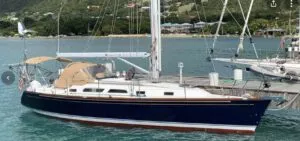
Unlike most modern boats, the interior furniture is constructed in place and glassed to the hull, adding structural strength to an already rigid hull. There is no separate ceiling liner. The finely finished deck head is simply the inner surface of the cored sandwich with plugs covering deck hardware fasteners. An elegantly simple solution as it emerges from the factory. Adding deck hardware, however, may become an issue with some extra work required to reinforce the core.
Although bonded to the hull, the teak bulkheads are not mechanically fastened to the deckhead. Instead, the bulkheads are set into molded recesses in the solid ceiling. Interestingly, aboard Amiskwi in heavy seas, the aft cabin bulkhead generated “old wooden boat” creaking noises. This was remedied by injecting a sealant into the joint where the bulkhead fit into the ceiling grove.
The Sabre 386 was designed with a choice of exposed lead keels, the deep draft fin (6’ 10”/ 2.08m) with the completed boat weighing in 16,900 lbs. (7,688 kg) or the shallow draft (4’9” / 1.5 m) at 17,300 lbs. (7,847 kg), both with a modified bulb at the bottom. The rudder is an elliptical foam core with a carbon fiber post, connected to the wheel by quadrant/wire system. Of the three Sabre 386s that I am aware of locally, all three suffered a skin delamination on the port side of the rudder, top to bottom. On Amiskwi the rudder was re-built, something to be aware of if contemplating a purchase.
ON DECK
First impressions on deck are of a clean, uncluttered space surrounded by a beautiful teak toe rail. The long coach roof slopes gently to the bow with off-white molded-in non-skid complementing the white gelcoat and teak toe rail. Stainless steel handrails provide a hand-hold, but stop at the mast. I find it curious that there are no handrails from the mast forward along the coach roof. There is certainly room for them. Two Dorade vents over the aft end of the coach roof and a pair of large opening hatches provide plenty of ventilation below deck. The side decks are somewhat obstructed by the shrouds set into a single chainplate on each side abeam the mast, mid deck. However, there is plenty of room to pass by these stays in or outboard, a welcome option when heeled over in boisterous seas.
Internal halyards exit the mast high enough to allow for a rapid jump hoist by deck crew, then out to deck organizers before reaching back to Lewmar 40 self-tailing winches and line stoppers at the trailing edge of the cabin top. This set-up is perfect for the racing crew on deck as well as the single-handed sailor remaining in the safety of the cockpit. The starboard halyard winch is a powered Lewmar 40, very nice to have for the big mainsail. The genoa winches are self-tailing Lewmar 50s accompanied by self-tailing Lewmar 46s for the spinnaker, both within reach of the helm.
Foresail tracks are recessed into the side deck from abeam the mast to the leading edge of the cockpit. Control lines provide adjustability for car position, the design and quality allowing movement under load. For larger genoas and spinnakers an additional track is set up atop the teak toe rail from abeam the mast to the stern. This allows for plenty of options for sail shape. The back stay is split with a hydraulic adjuster on the starboard corner.
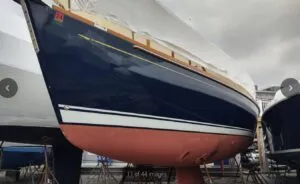
At the bow the stainless-steel anchor rollers have room for two anchors, the rode leading back to a vertical Lewmar windlass and a very deep anchor locker. Plenty of room here for boat fender storage. Climbing into this locker provides easy access to the base of the windlass for maintenance. Stainless steel chocks set into the toerail provide dock line access without damaging the teak. Aboard Amiskwi the Harken furler drum is set high on a toggle to avoid conflict with the anchor function.
Double stainless lifelines provide security on deck with side-deck gates just forward of the cockpit. There is also a gate leading up from a small boarding step molded into the stern, very convenient when boarding from a dinghy. A swim ladder is set into the step for safety.
Despite making allowances for the stern cabin just below, the well-proportioned T shaped cockpit is deep and feels very secure. The coaming is high and well angled for back support. The top of the coaming is the perfect position for driving the boat, from the lee or weather side. The footwell is deep and the opposing seat is within reach for bracing when heeled over. The cockpit is not overly spacious when compared to other boats in the same size range. The pedestal and large wheel tend to dominate the relatively small space. Chris has extended the pedestal guard to accommodate sailing and navigation instruments, further intruding on this limited space. Behind the wheel there is a raised helm seat flanked by two deep stern lockers, the lockers connect underdeck. The starboard side holds the shore power connection and forced-air heating system, the port side the hot water tank. There is plenty of white melamine cabinetry in these lockers to protect steering gear and other hardware, but it’s all removable and, once removed, there is enough room that the average sailor can easily climb into this space to service equipment.
The port cockpit locker is shallow due to cabinetry covering the 40-gal. (151 liter) fuel tank. Certainly not a space that you can climb into. The melamine cabinetry is removable which allows a bit more room to work in here. It’s handy for cleaning equipment, fenders and dock lines. The port side seat can be raised to open the aft cabin hatch, allowing light and ventilation into that space when the cockpit is not in use.
Engine throttle and gear shift are a single lever on the starboard side of the binnacle, right where they should be. The standard Yanmar engine control panel is high on the starboard cockpit coaming, clearly visible through a hinged plexiglass cover, unlikely to fall prey to a collision from errant boots.
BELOW DECK
A low bridge deck step-over leads to the recessed companionway. A stainless-steel handrail around the top of the opening accompanies teak handrails down the four steps into the main cabin, plenty of hand holds. First impressions are of a very warm and welcoming cabin finished in glowing American Cherry paneling and trim.
Immediately to starboard is the door to the head. A relatively spacious shower compartment is separated with a plexiglass door. The finish is all gelcoat and melamine cabinetry, bright, airy, and easy to keep clean. Two opening ports and a deck hatch ensures moisture can escape and fresh air can enter. A small vanity sink on a composite countertop accompanies a fresh water electric toilet that flushes into a small holding tank behind cabinetry in the shower compartment. The tank is irregular in shape and a waste -evel sensor was added to limit the chance of an overflow. From the factory there is no option for direct discharge overboard once outside the limit. A small locker at the sole is used mainly for footwear.
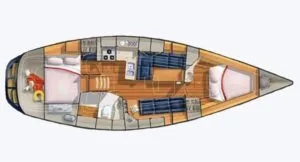
To starboard of the companionway is the U- shaped galley with a deep double sink on a composite counter near the centerline. Faucets include hot & cold pressure water accompanied by fresh & saltwater hand pumps. The pressure pump is located under the galley sink, fed from the two 50 gallon (132 liter) water tanks located under the settees. A low plexiglass splash shield keeps sink water out of the salon and yet provides an open, airy feel to the galley. A gimbaled three-burner Force 10 propane range is located against the hull with a cavernous cold-storage compartment (refrigerated) adjacent. The cold storage unit has both a top loading lid as well as a front opening door, both well insulated. The factory Seafrost refrigeration system is located behind the port-side settee. Above the range is a small microwave set nicely into the cabinetry. There is an abundance of storage behind louvered doors but only a limited number of drawers. With the stove, icebox lid, a refuse lid and double sink, there is a severe shortage of working counter space. Sabre does provide composite sink “toppers” that provide a bit more space, but that limits sink access. A small flip-up cutting board next to the sinks resolves this shortage somewhat.
Astern of the galley, through a solid door, is the aft cabin. There is a coil spring double mattress arranged athwartships. There is plenty of storage against the hull along with a separate cedar-lined hanging locker. A large opening hatch under the port cockpit seat brings in light & fresh air. Unfortunately, the bed isn’t quite wide enough to sleep longitudinally. It shouldn’t be considered a sea berth when heeled over. Trust me, I tried!
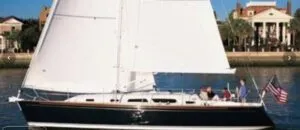
Forward of the navigation station and galley the interior opens into the main saloon. Aboard Amiskwi the teak and holly sole complement the tan upholstery. The starboard settee stretches from the navigation station to the bulkhead, the port settee is L shaped and can be pulled into a double berth. Both are long and wide enough to be very comfortable sea berths. Chris has added lee cloths to make them so. The beautifully finished table folds up against a bulkhead bookcase when not in use, folding out across the cabin when guests are aboard. Six can be seated comfortably. The mast intrudes into the main cabin just aft of the forward bulkhead but is nicely wrapped in fabric, matching the settees. There is plenty of storage behind the seat cushions as well as against the hull above the seat backs in open storage and beautifully finished closed cabinetry. The massive chainplates are clearly visible for inspection. Under-seat storage is non-existent. This space is taken up with water tanks and batteries. There are four 12-volt AGMs, three on the centerline and one under the navigator’s seat, all readily accessible. Battery switches are at the foot of the port-side settee opposite the navigation station.
The light, airy feeling of the salon is complemented by the white textured ceiling with cherry battens running longitudinally. The large deck hatch accompanies two opening ports and four fixed ports providing plenty of ventilation and light below. Handrails run the length of the cabin below the ports.
The V berth is separated from the main cabin with a solid door. The hull here is lined with light wood slats with American Cherry trim, no bare fiberglass or vinyl for Sabre Yachts. An open shelf runs the length of the cabin on both sides with a pair of small lockers near the forepeak. The bed is what I would call a semi pedestal arrangement, the shoulders of the sprung mattress being accessible, the foot of the bed against the forepeak. A six-footer can stretch out here! There is a small cabinet for storage to port with a sink and pressure water. A substantial cedar lined hanging locker is to starboard. Additional drawers slide under the berth providing convenient storage above two small lockers at the cabin sole. As there are no tanks or mechanical devices below the berth, storage is remarkable, just difficult to get to. A deck hatch and two opening ports provide light and ventilation.
MECHANICAL
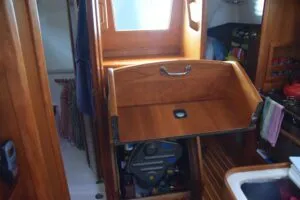
The 40-hp Yanmar 3JH4E diesel is enclosed in an insulated compartment below the cockpit sole. Access is reasonable through the pivoting companionway stairs, a substantial removable cabinetry in the aft cabin and side hatch in the head compartment. The stairs pivot up and prohibit access to the cockpit engine control panel while servicing the engine. A secondary starting switch would be appropriate for engine servicing. The oil filter is on the starboard side of the engine against the head compartment wall, very difficult to access from the front. The removable shower stall panel provides better access. The transmission is accessible from the aft cabin with the shaft and shaft seal under removable panels.
UNDERWAY
Under power I found the Yanmar a bit noisier than expected, considering the level of sound insulation and Sabre pedigree. The standard water-lift muffler is adequate but could be improved with a secondary silencer. There is plenty of power through the three bladed Maxiprop for maneuvering in close quarters. A tight turning radius and limited prop walk in reverse gives the helmsperson with confidence. The boat goes where it’s pointed.
In open water with a throttle setting of 2,600 rpm a comfortable cruising speed of 6.5 knots is reached. The Yanmar is rated at 2,900 continuous RPM and can reach the 7.6 knot hull speed if necessary.
Like many classic hull shapes, the Sabre 386 performs best under sail. With a relatively deep underbody amidships and no flat bottom forward or aft of her fin keel, this 17,000 lbs boat will likely not be surfing downwind but is exceptionally stable when reaching and pointing. She leans into the wind and shoulders her way through the waves with a remarkably comfortable ride. Boisterous seas may splash aboard forward but the high coamings prevent the water from entering the cockpit.
Standing at the wheel is aided by the tilted sole in the T shaped cockpit, providing level footing when healed over. Seating on the raised helm seat allows a forward view over the coach roof. The best seating, of course, is on the wide cockpit coamings using the pushpit as a back rest. The view forward for sail shape is unobstructed.
CONCLUSION
Having sailed aboard Amiskwi in both local races and over long distances, the Sabre 386 is not a lightweight flyer set to dominate the round-the-buoys fleet. More a cruiser/racer than racer/cruiser, the slippery hull and deep keel with spade rudder does well against the younger up-starts with their flat bottoms and wide sterns. In ocean seas there is a sense of poise and confidence while shouldering aside unruly waves. With a beautifully elegant design and sound construction, the Sabre 386 is definitely a first-class coastal cruiser with the capability of an ocean cruiser. Turning heads at anchor or secured to the dock, this fine example is the epitome of a classic yacht.




























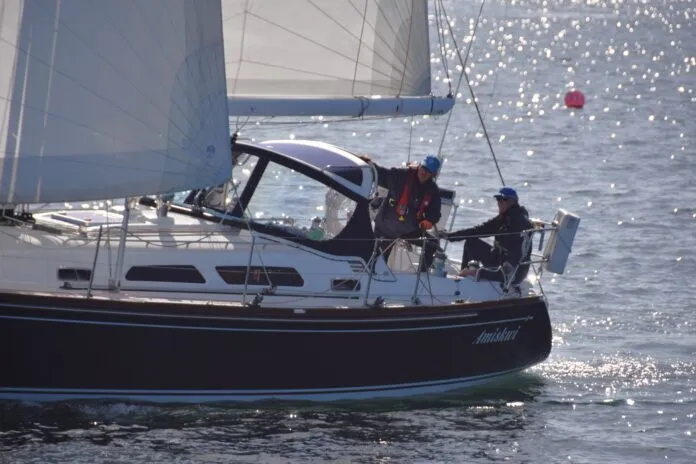

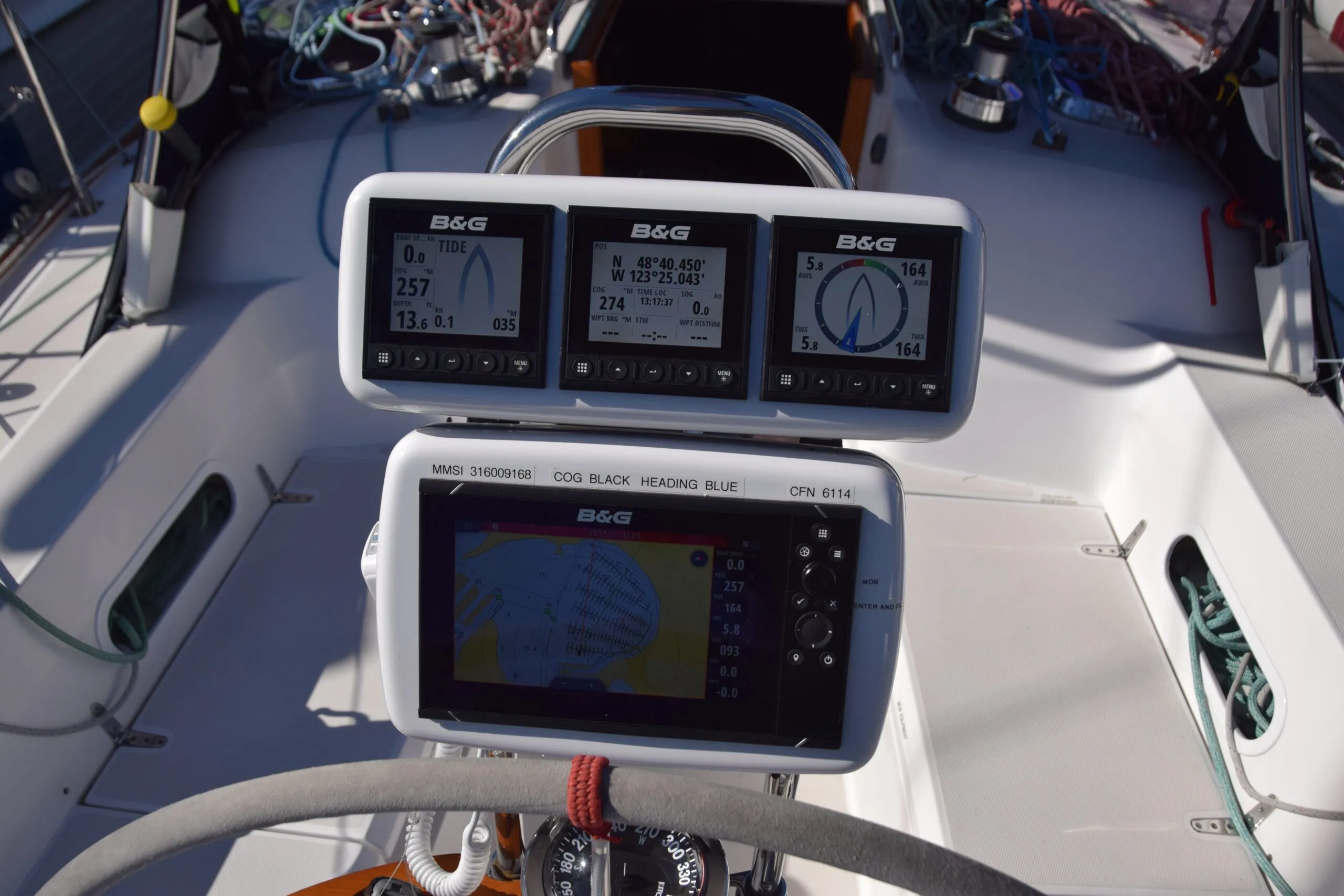
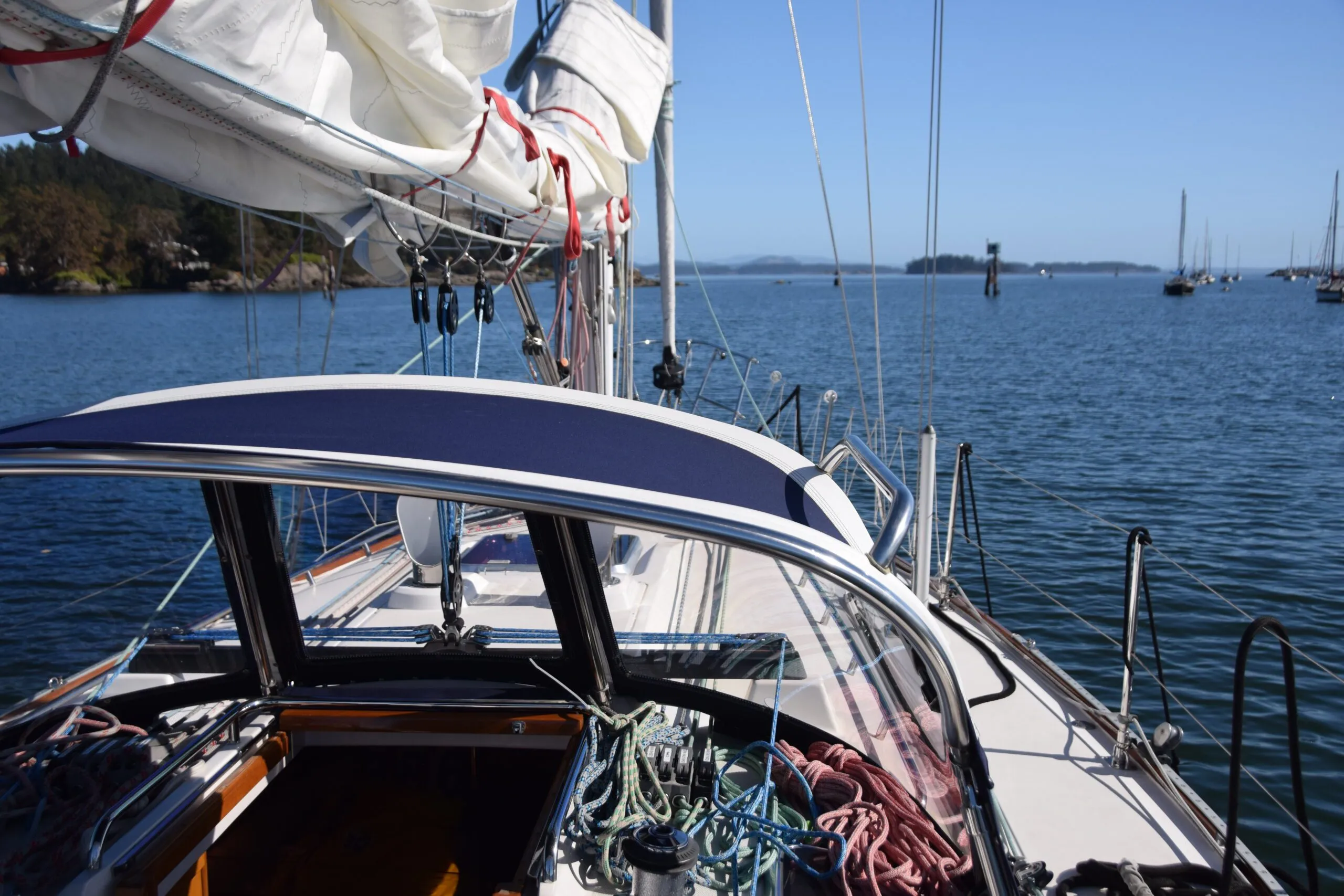
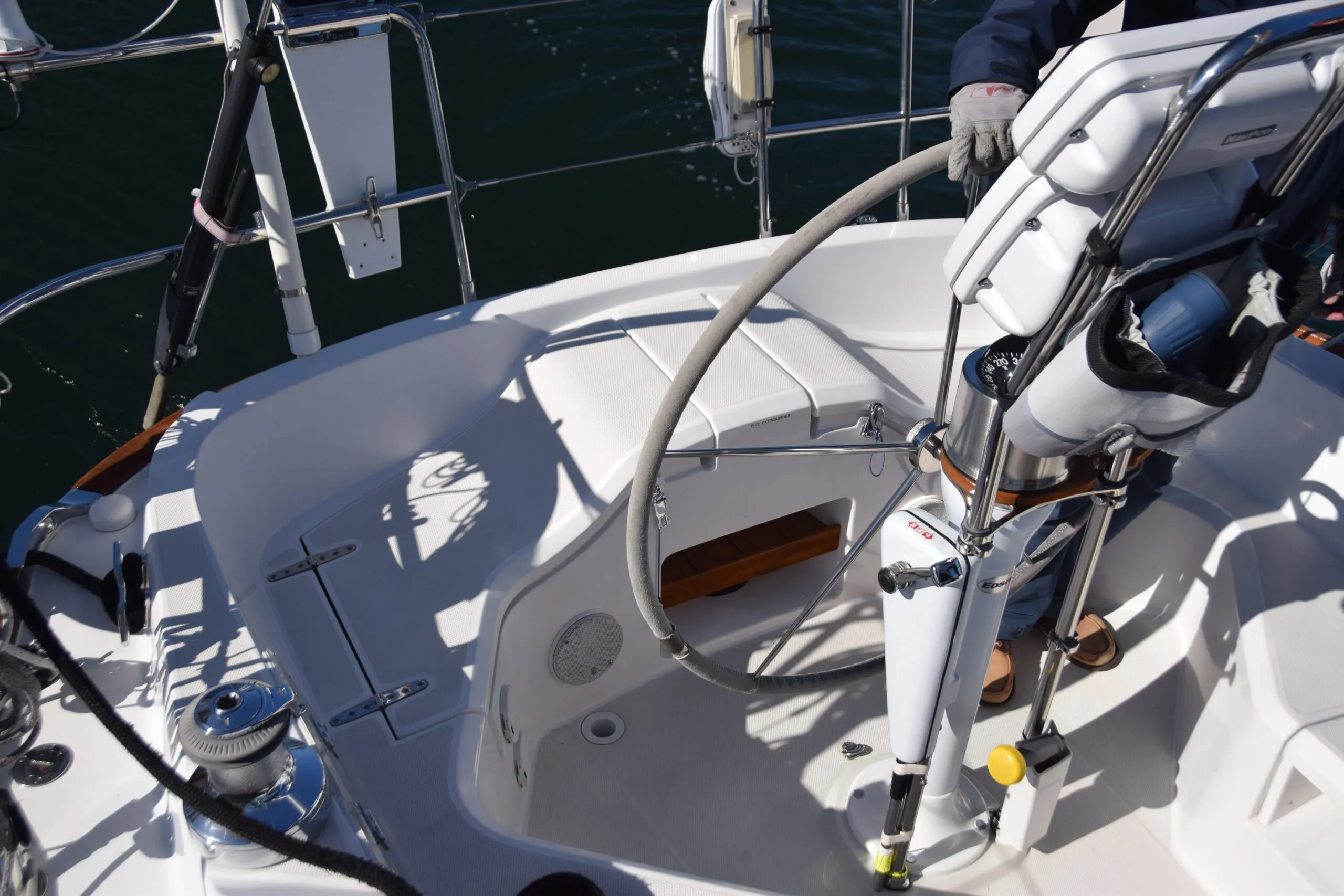

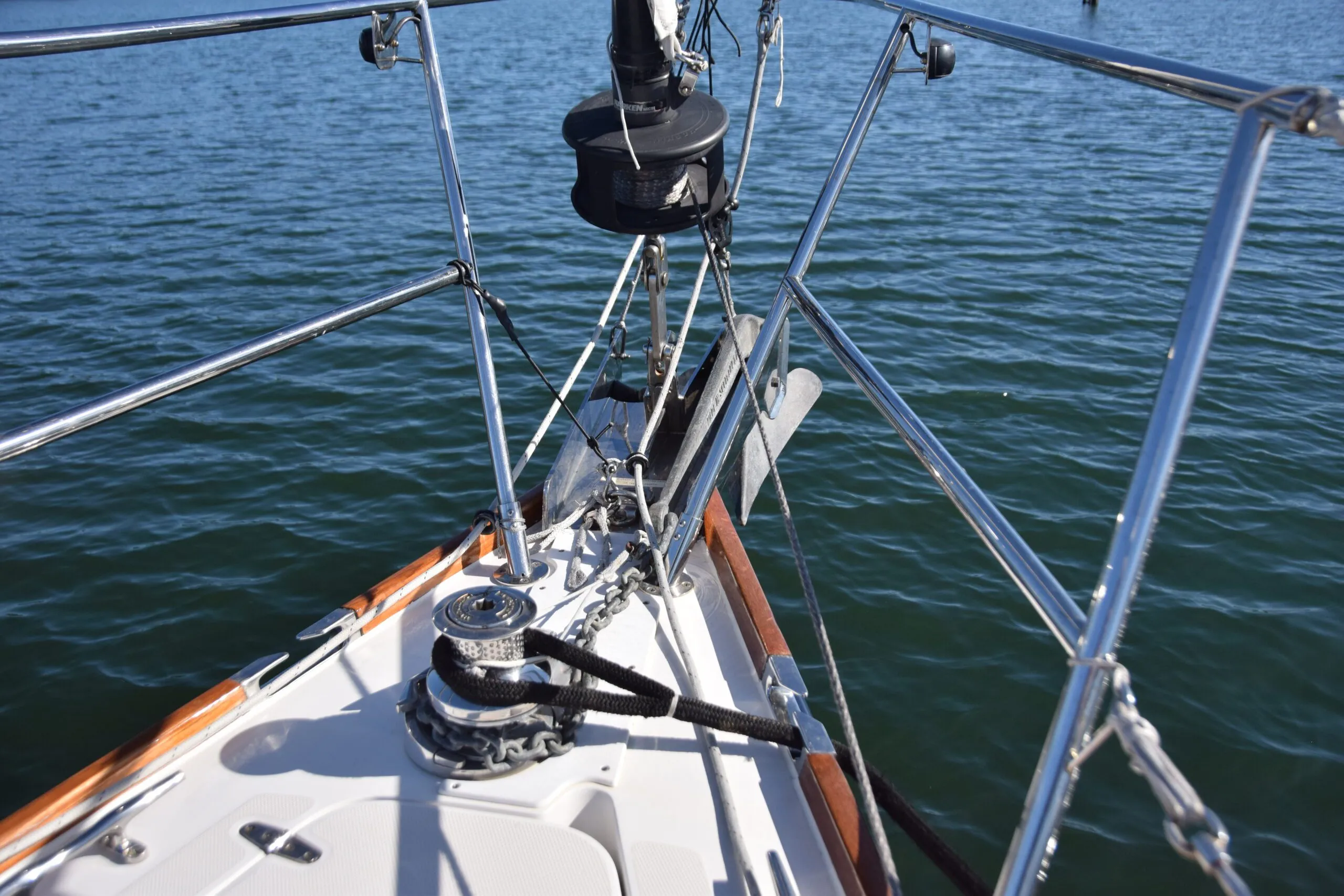

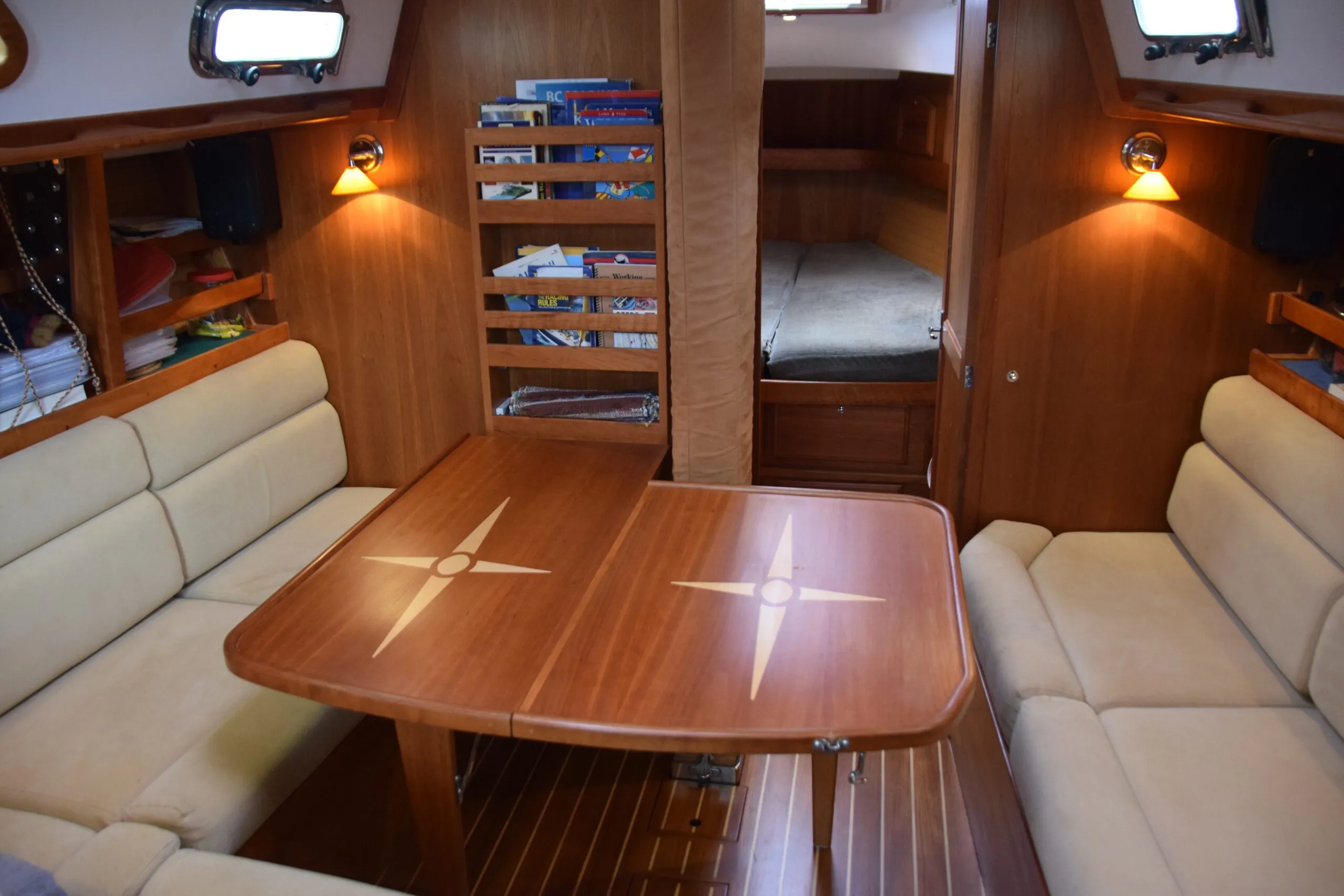
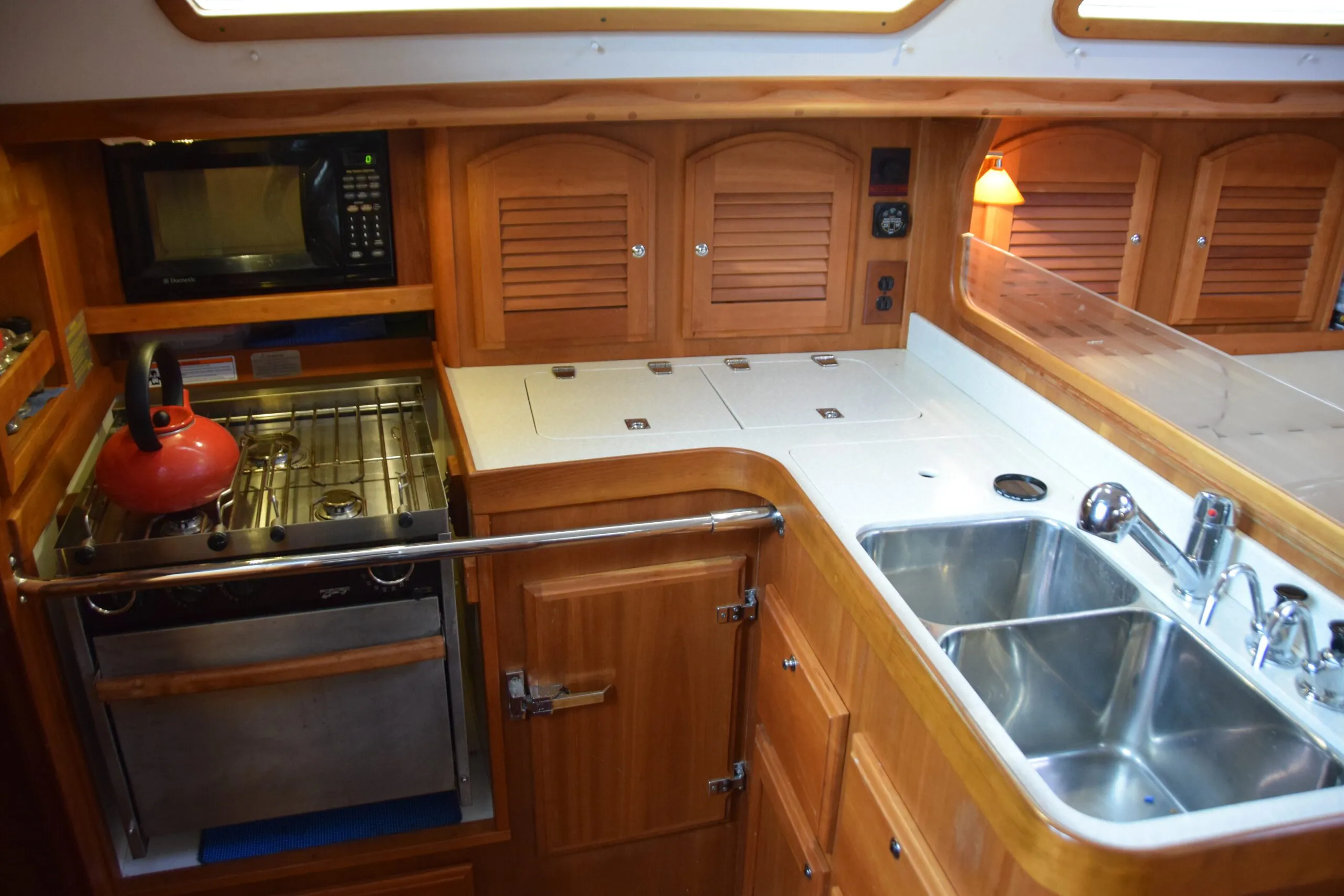
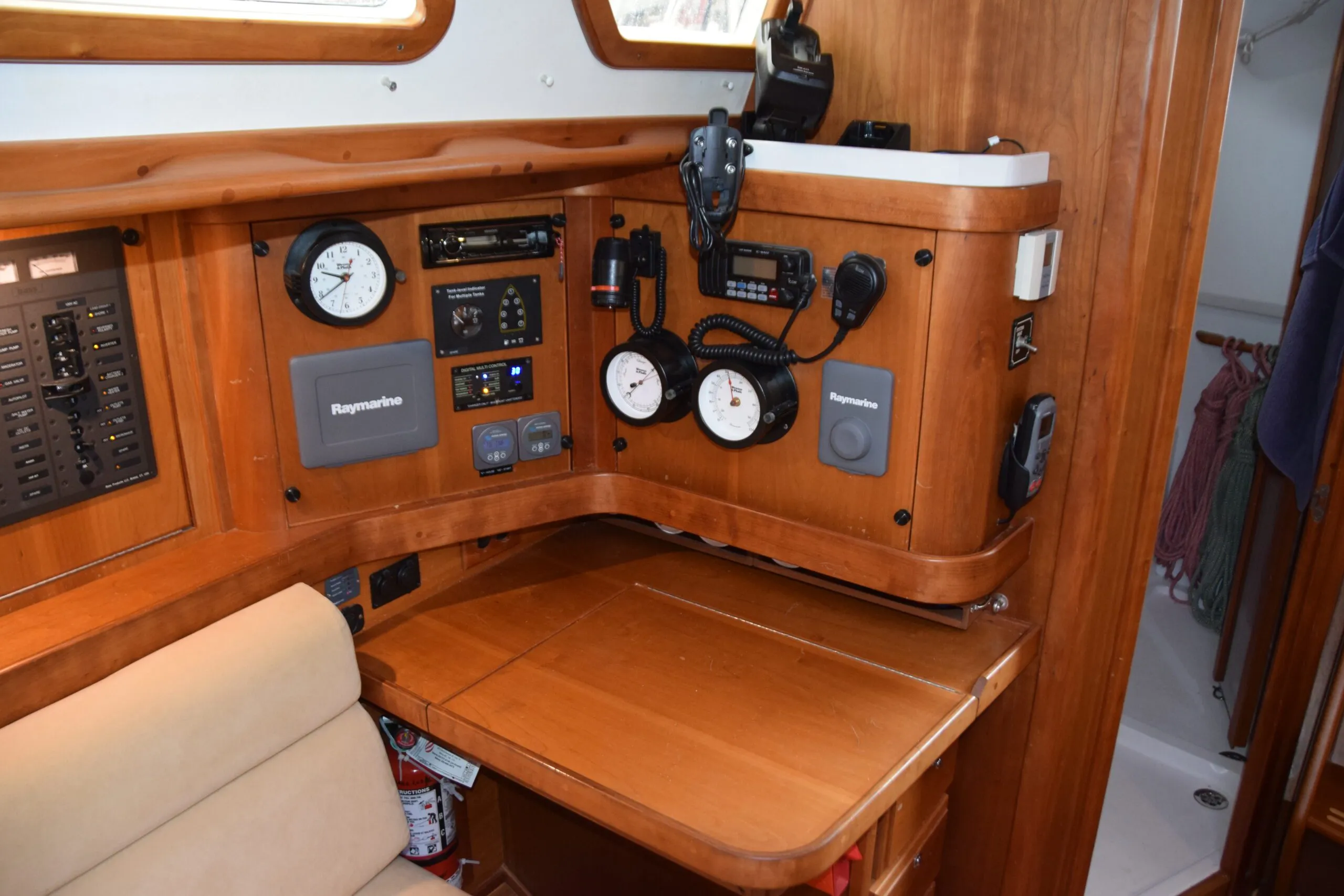






Nice appreciation of a very nice boat.
“To starboard of the companionway is the U- shaped galley….” While I’ll grant that what looks like an L- shaped galley in plan, feels like a U with the bulkhead just aft, placing it to starboard seems like a simple typo. Seafaring history is filled with more serious examples of what my father used to call, “The Reciprocal Problem.” While aft-facing nav stations are often good space savers, it is a potential source of just this trouble and requires extra care translating from the chart table to the deck.
Couldn’t access the rest of this article for some reason in spite of signing in as a member.
While I Am on ultrafast WiFi, and have logged in, signed in, logged on and am recognized by the site as indeed who I am, I can’t download or read the Sabre 386 review or any other articles?
Very frustrated, Shawn
My wife and I are still sailing hull #1 which we bought off the floor at The All Sail Show at Navy Pier in February 2004 and still love her (Granuaile) ! She sails like a dream and is very comfortable down below.